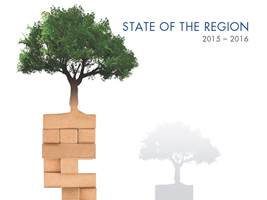 Executive Summary
Executive Summary
The Asia-Pacific is forecast to grow by 3.2 percent in 2015, the lowest level since the Global Financial Crisis before returning to what has become the ‘new normal’ growth of around 3.4 to 3.5 percent. Growth for both advanced and emerging economies in the region is significantly lower than before the crisis years, indicative of the important structural changes taking place both within regional economies as well as in the Asia-Pacific region as a whole.
Several initiatives are under way that could help to boost growth including the launching of the Asian Infrastructure Investment Bank (AIIB), the Trans-Pacific Partnership (TPP), and the Regional Comprehensive Economic Partnership (RCEP). However, much more is needed. Increasingly, economies aspire to, and demand, growth that is sustainable and inclusive. This raises the very real question of where such growth will come from. As tariffs, quotas and other trade barriers have fallen with trade liberalization, the focus of efforts to generate growth has shifted to structural obstacles that create behind-the-borders barriers to business. Structural reforms are changes in government institutions, regulations and policies designed create a business environment that supports efficient markets. The goal of structural reform is to bolster the strength and efficiency of markets in order to enhance living standards.
The overarching theme for this year’s series of APEC meetings has been inclusive growth. Previous PECC surveys have indicated relatively low levels of satisfaction across the region with efforts to make growth more inclusive. According to the results of the 2015 State of the Region survey, the top 5 most important issues to promote inclusive growth were:
• Provision of public education
• Reducing corruption
• Providing support to micro, small and medium enterprises
• Quality of health services
• Social safety nets including healthcare, unemployment and pensions reforms
These broad themes were also reflected in the policy community’s views on what should be the top priorities for APEC leaders’ discussions in Manila, which were:
• Progress towards the Bogor Goals and the Free Trade Area of the Asia-Pacific (FTAAP)
• The APEC Growth Strategy
• SME participation in regional and global markets
• Corruption
• Climate change cooperation and disaster resilience
• Improving human capital development
• Physical, institutional and people to people connectivity
• The development of regional financial systems
• A major APEC initiative on services
• The reform of regional institutional architecture
As seen from the results of the survey, there is an urgent need for the region to focus on achieving growth – growth that is not only strong but sustainable and inclusive. APEC’s work through the growth strategy as well as other subsequent initiatives such as the agreement on environmental goods, the APEC Connectivity Blueprint and the Free Trade Area of the Asia-Pacific have helped to give the organization a renewed sense of purpose in the middle of its third decade of existence.
At the mid-point in between the deadlines for the achievement of the Bogor Goals for industrialized APEC economies 2010, and for developing economies 2020, it is clear that new, innovative approaches are needed to allow economies to effectively reap the benefits of regional economic integration. While there have no doubt been successes, barriers to services in particular – not just cross-border trade in services but barriers to the efficient delivery of services are a crucial concern. As indicted throughout the survey findings; levels of satisfaction with services in the region are low – whether in electricity, transport, healthcare or education to mention just a few.
Survey results from previous years that indicated a waning of support for APEC have since been replaced by a strong endorsement for its continued relevance in a region where multilateral initiatives have been proliferating. Maintaining that relevance will be a critical challenge as APEC moves on to try to achieve some difficult but critical objectives.
Regional economic integration in the Asia-Pacific region has been one of the defining characteristics of the past quarter of a century supported by technological change and policy changes such as the liberalization and facilitation of the flows of goods, services, capital and people. While some might consider the integration and globalization processes as inevitable, the drop in PECC’s index of integration during the crisis years showed what that ‘dis-integration’ is a real possibility. It was only through concerted efforts to avoid protectionist policies that a much worse outcome was prevented.
When APEC Leaders set out the Bogor Goals in 1994, they set out a vision through which the region would not only maintain high growth rates but also narrow development gaps. While the region has done well in integrating and overall incomes have increased at a dramatic pace, PECC’s index and survey results show that there is a long way to go in terms of closing development gaps.

